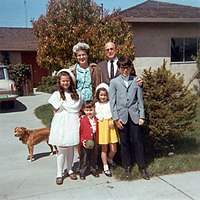Vernacular photography

Vernacular photography or amateur photography refers to the creation of photographs by amateur or unknown photographers who take everyday life and common things as subjects. Though the more commonly known definition of the word "vernacular" is a quality of being "indigenous" or "native," the use of the word in relation to art and architecture refers more to the meaning of the following subdefinition (of vernacular architecture) from The Oxford English Dictionary: "concerned with ordinary domestic and functional buildings rather than the essentially monumental." Examples of vernacular photographs include travel and vacation photos, family snapshots, photos of friends, class portraits, identification photographs, and photo-booth images. Vernacular photographs are types of accidental art, in that they often are unintentionally artistic.
Closely related to vernacular photography is "found photography," which in one sense refers to the recovery of a lost, unclaimed, or discarded vernacular photograph or snapshot. Found photos are often found at flea markets, thrift and secondhand stores, yard sales, estate and tag sales, in dumpsters and trash cans, between the pages of books, or on streets and sidewalks.
The use of vernacular photography in the arts is almost as old as photography itself. Vernacular photography has become far more commonplace in recent years as an art technique and is now a widely accepted genre of art photography.
Vernacular photographs also have become popular with art collectors and with collectors of found photographs.
See also
External links
- Accidental Mysteries Collection of John and Teenuh Foster
- Ampersand Vintage Website
- Bighappyfunhouse: Found Photos - Free Pie
- Boston University Vernacular Reframed: An exhibition and conference on vernacular photography
- Boston University In the Vernacular: Everyday Photographs from the Rodger Kingston Collection
- Found Photos on Livejournal A collaborative found photography project
- Gargantua Photos
- Paul Greenleaf British artist using vernacular photography in his work
- Junk Shop Photos Unusual, vintage photos discovered in junk shops.
- Laughter is the Spackle of the Soul A gallery of found photos and lost memories, 6 photos added per month
- Least Wanted: a century of american mugshots
- Look at Me: A Collection of Found Photos
- Museum Of Vernacular Photography Exhibitions Exploring The Depth And Scope Of Vernacular Photography.
- The Secret Notebooks A Story From Found Photographs
- Spillway Categorized Found Photographs and Printed Matter
- Square America A gallery of vintage snapshots and vernacular photography.
- Vintage Pixels A collaborative database of found vintage photos. Free for use in amateur and commercial projects.
- ThreeFarmers A catalog of found photos and objects.
